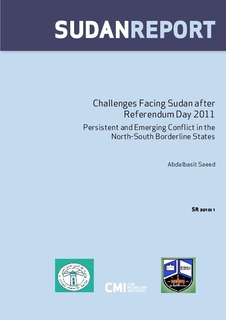Challenges facing Sudan after referendum day 2011. Persistent and emerging conflict in the north-south borderline states
| dc.contributor.author | Saeed, Abdalbasit | |
| dc.date.accessioned | 2018-01-04T08:19:38Z | |
| dc.date.available | 2018-01-04T08:19:38Z | |
| dc.date.issued | 2010-01-01 | |
| dc.identifier | oai:www.cmi.no:3926 | |
| dc.identifier.citation | Bergen: Chr. Michelsen Institute (Sudan Report SR 2010: 1) 27 p. | |
| dc.identifier.isbn | 978-82-8062-290-7 | |
| dc.identifier.issn | 1890 7059 | |
| dc.identifier.uri | http://hdl.handle.net/11250/2475018 | |
| dc.description.abstract | With the referendum on the self-determination of South Sudan scheduled for January 9, 2011, Sudan will enter the final phase covered by the Comprehensive Peace Agreement of 2005. If South Sudanese vote, as expected, in favour of independence, a new country will emerge after a final six-month transition period. If a new war is to be averted, the two successor countries must find a basis for building relations of cooperation and collaboration rather than confrontation. They must deal with multiple post-referendum issues, including division of oil revenues, collaboration on the production and transport of oil, population movements across the border, and more. Among the most volatile issues will be disputes about borders and contested resources—especially arable land, pasture land, and water access points—in the sensitive “borderline belt” that stretches across the country from west to east. Read Abdalbasit Saeed's referendum blog: | |
| dc.language.iso | eng | |
| dc.publisher | Chr. Michelsen Institute | |
| dc.relation | Sudan Report | |
| dc.relation | SR 2010: 1 | |
| dc.relation.ispartof | Sudan Report | |
| dc.relation.ispartofseries | Sudan Report SR 2010: 1 | |
| dc.relation.uri | https://www.cmi.no/publications/3926-challenges-facing-sudan-after-referendum-day-2011 | |
| dc.subject | Sudan | |
| dc.title | Challenges facing Sudan after referendum day 2011. Persistent and emerging conflict in the north-south borderline states | |
| dc.type | Research report |
Tilhørende fil(er)
Denne innførselen finnes i følgende samling(er)
-
Publications [1488]
